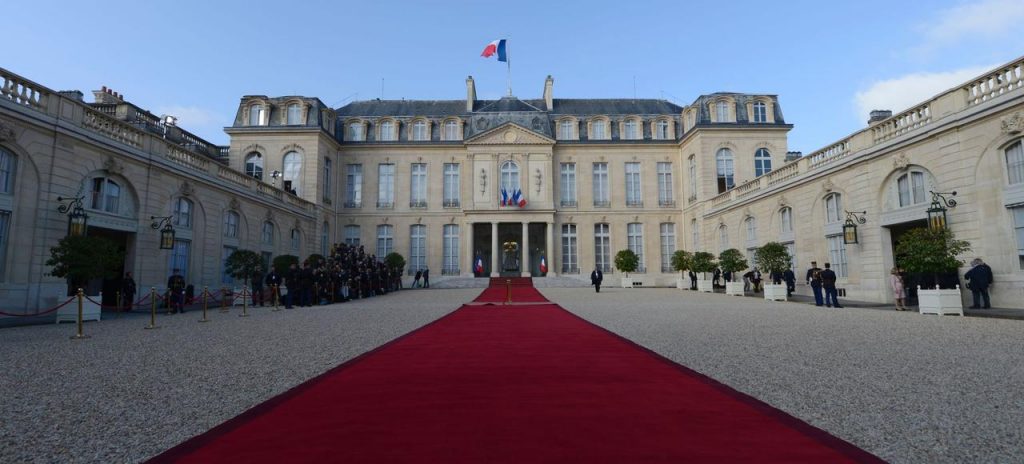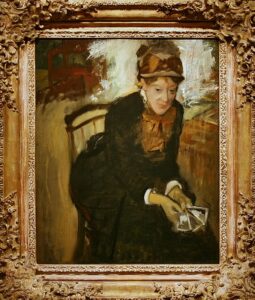The Élysée Palace is the presidential house in France, the equivalent of the American White House. Synonym of power, the Palace has been the home of kings and presidents of France one after the other. From its construction to present day, the Elysée has been the witness of dramas, romantic affairs, political betrayals, and comical anecdotes. History has been made between its walls. The Elysée Palace has seen everything, from state visits by foreign leaders to salacious scandals: this is why it is so fascinating. It is also a window into French culture.1

At the beginning of the eighteenth century, the Elysée Palace began as the Faubourg Saint-Honoré on a grassy hill in the country surrounded by a few farms. As Paris grew, it became located between the street Faubourg Saint-Honoré and the Big Courts along the Champs-Elysées Avenue.2
The architect Armand-Claude Mollet possessed land that he sold in 1718 to Henri-Louis de la Tour of Auvergne, count of Evreux.3 The contract stated that Armand-Claude Mollet would be in charge of building a hotel there; it was intended to be the residence of the count of Evreux. The Hotel was built and decorated between 1718 and 1722. The gardens of the Elysée is a shaded and flowery two hectares of countryside. When the count of Evreux built the courtyard in 1718, he installed formal French gardens characterized by symmetries and perspectives. The gardens were meant to demonstrate the power and fortune of its owner.4 At his death in 1753, the count of Evreux left the most famous hotel of its time. It was admired by all, including Blondel, considered the best French architect of the eighteenth century, who described it as, “the most beautiful country cottage of the Paris’ neighborhood.”5

The decoration of the Palace started with the women, mistresses, and wives of kings and presidents, who contributed to the embellishment of the property. Before the Elysée was home to presidents of the Republic, it belonged to France’s kings, starting with King Louis XV, who gave the Hotel of Evreux—ancient name of the Élysée Palace—to his mistress, the Marquise de Pompadour, Jeanne Antoinette.6 The Marquise was very interested in the gardens of the property, because she had a little girl and she made a playground out of them that was something of an ancestor to Disneyland. Because of her young spirit, it was a playground for the Marquise as well. As the fashion was to play at being a shepherd, the Marquise had a herd of sheep. One day she tried to let them in her apartment, where the walls were covered with mirrors. The poor animals, terrified, found themselves lost, and destroyed the place, causing a scandal.7

The sculpture in one of the gardens made by François-Xavier Lalanne reminds us of the affection that the Marquise had for the small animal. She also gave luxurious dances in her gardens. The parties reflected the image of the owner of the place: extravagant, luxurious, and sophisticated. 8
The Elysée Palace will be long remembered as a place of reception, culture, and pleasure for Parisians and for the many visitors who come each year to see it.
- Véronique Rampazzo and Patrick Lesueur, L’Elysée (Le Cherche Midi, 2010), 6. ↵
- Véronique Rampazzo and Patrick Lesueur, L’Elysée (Le Cherche Midi, 2010), 8. ↵
- Georges Poisson, L’Élysée: histoire d’un palais (Pygmalion, 2010), 523. ↵
- Jacques Santamaria Duhamel, L’Élysée, coulisses et secrets d’un palais (Plon, 2012), 395. ↵
- Présidence de la République, Le Palais de L’Élysée et son histoire (www.elysee.fr, 2015). ↵
- Evelyne Lever, Madame de Pompadour: a Life (New York: Farrar, Straus and Giroux, 2002), 35, 37. ↵
- C. Leroux-Cesbron, Le palais de l’Élysée, chronique d’un palais national (1925), 44. ↵
- Claire Bommelaer, Visitez les jardins de l’Élysée (www.lefigaro.fr, Le Figaroscope,2012). ↵



28 comments
Abigale Carney
Very interesting article! I have never heard of this French White House, it is kind of funny that both the US and France have similar “white houses”. The history of this beautiful house is so cool, I had no idea how long it has been around! Also learning about the events held at the property were very interesting to hear! Cool article!
Veronica Spryszynski
I think I’ve seen the french white house in the movie pink panther. Its very similar to the White House we have in Washington DC. I never knew the French White House dated back to the king Louis XV, and I liked how the gardens were special to the daughter of the two, the place is very pretty and and the history behind it seems endless.
Evelin Joseph
I never before knew of this French White House, so this article was truly informational and beneficial to me. This article was different and introduced the story of a building, which seems hard to do, really well. I love that you described the playground as an “ancestor to Disneyland” and helped me gain a better understanding of the scale of this property. Learning about the various events that took place in the property was really enjoyable, and I especially liked the scandal involving the herd of sheep.
Soteria Banks
I liked this article its different, I think that a lot of our articles are about people, and culture. i like how the story is told, its flows really well, the pictures make it a better story. i always wanted to go to France ever since I’ve seen the parent trap. The François-Xavier is so unique in every way. They cherish the old things and take care of it for many years, i wish America had buildings like this .
Alexandria Martinez
This was a good story, it was interesting to learn about the different things that the Elysee went through. Before this I had no idea that there was actually a place like the White House outside of the United States. This article was very informative and funny because of what the girl did to those poor sheep. She must have confused them really bad with all of those mirrors.
Deanna Lummus
This article interested me because there are so many things that happened year and years ago that we will never know about. However, buildings like this one have seen it all and still stand. This article gives a whole new meaning to the phrase “if walls could talk”. I think this story shed some comical light on a place devoted to kings and presidents who deal with so much serious business, but yet mother nature and her animals will never let us go without a laugh one in a while.
Alexis Soto
This article was a great! It was interesting and had great structure. It managed to explain the history of the Palace with enough details to keep the reader interested. Personally, I had no idea the French had a historic place their Presidents, kings previously, stayed. Now I want to visit the palace if I ever get the chance to visit France.
Christine Sackey
Wow! The pictures are so beautiful! I always thought that the French architecture was outstanding. I liked the story about the garden. I can not imagine living in a property where your backyard is like Disneyland. I had read about King Louis XV who threw elegant parties that were out of this world. This place is certainly on my bucket list to visit now.